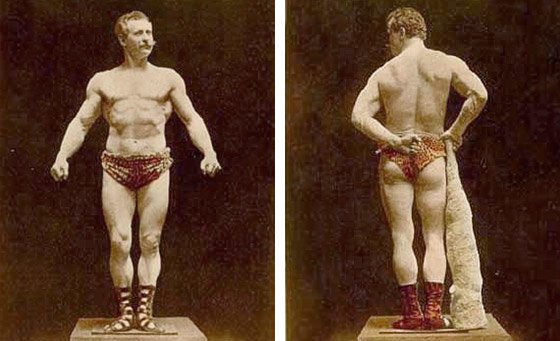The physical culture of muscle-building has attracted followers for many years; well before the advent of competitive bodybuilding as we know it today.
Followers of the iron game will know that bodybuilding in its popular form began in earnest in the 1890s with the arrival of Mr. Eugene Sandow, whom the Mr. Olympia statue is modelled on.
However, weight training as a general athletic activity was initially practiced as a means to gain strength and measure power in ancient Egyptian and Greek societies. These societies would primarily use stones of various sizes and weights (a practice that would occur in one form or another throughout history) in their quest for body transformation. The celebration of the human body through muscular development was, in fact, one of the Greek ideals.
Physical culture (distinguishable from bodybuilding per se due to the lack of specific physical display as an end goal) can be traced back to 11th century India where stone dumbbell weights, known as Nals, were lifted by those wanting to develop their bodies to enhance health and stamina to help overcome the challenges of daily life. Gyms were commonplace in India during this period, and by the 16th century, weight training is thought to have been India’s national pastime.
There was to be a long period between the 16th century physical movement in India and the beginning of bodybuilding (defined as training and dieting to develop one’s body specifically for exhibitive purposes) as we know it today.
THE EARLY PERIOD 1890-1929
Toward the end of the 19th century, weight-training took on a new meaning for many, as the ancient tradition of stone-lifting, practiced initially by the Greeks and Egyptians, made way for a completely new system of training, with a new end-goal. Weightlifting for entertainment purposes emerged in Europe, signalling the beginning of a physical culture never before seen.
The intention was not to develop one’s physique into a glorious spectacle per se, but to thrill crowds with amazing feats of strength—the professional strongmanwas the outcome of this intensified interest in weight-training. The modern sport of weightlifting was somewhat of a natural evolution from the comparatively primitive practice of stone-lifting in dark, dank dungeons.
Not surprisingly, weightlifting exponentially grew in popularity so much so that today the practices during the early period of 1890 to 1929 would seem, at best, archaic. The practices of the late 19th century strongmen included issuing challenges to fellow strongmen to see who could outlift the other as they traveled from town to town.
Other practices included pulling carts and lifting animals, much to the amusement of onlookers. The public loved to watch these men compete, possibly for the novelty value if nothing else. How their physiques looked did not factor into these men’s displays of physical prowess. Indeed, a protruding stomach and thick, fatty limbs were commonplace among these competitors.
Symmetry and aesthetics were a foreign concept at this point. However, as the 20th century approached, a man who was to bridge the gap between the overweight and unsightly strongman and the bodybuilder as we know him today was to emerge.
Officially know as the first famous bodybuilder and the father of modern bodybuilding, Eugene Sandow (born Friedrich Muller), born in 1867, immediately became a phenomenon with his unprecedented combination of muscle quality and strength. He became a turn-of-the-century physical cultural icon who is referred to as one of bodybuilding’s greatest, even in today’s climate of genetic freaks.
Before the emergence of Sandow, proponents of physical culture were trying to find new ways to promote healthy lifestyles in line with the new phenomenon of weight training for the sake of physical demonstration. Tired of the overweight strongman image with its lack of emphasis on correct eating and high body-fat levels, they were looking for a representative who could promote the chiseled physique, and the subsequent ways of achieving this look. They found their man in Sandow.

Sandow himself started out in Europe as a professional strongman, outdoing all other strongmen to make a name for himself. He traveled to America in the 1890s to be billed as the world’s strongest man, travelling the country and impressing people with his extraordinary feats of strength.
The most amazing thing about Sandow, however, was his beautifully symmetrical and densely muscular physique, which eventually positioned him as the first real bodybuilder and promoter of bodybuilding. Indeed, Sandow published the first bodybuilding magazine (Physical Culture), developed some of the first bodybuilding machinery, and appeared in numerous books and postcards, while continuing to tour America posing to sold-out audiences.
While Sandow continued to promote bodybuilding, weight-lifting contests were officially held for the first time with the World Championships in England in 1891. Weightlifting was also featured in the first modern Olympic Games in 1896, in Athens, Greece. Due to Sandow’s influence, sales of barbells and dumbbells increased by a wide margin, and a whole bodybuilding industry was created, with Sandow earning thousands of dollars a week.
Sadly, Sandow suffered a fatal brain hemorrhage when, according to legend, he tried to pull his car from a ditch in the interests of physical display. Sandow’s legacy lives on in the increasing popularization of bodybuilding as a sport into the 21st century. Sandow judged the first bodybuilding contest ever held, and his image is immortalized on the current Mr. Olympia statue.
@jrfreak





